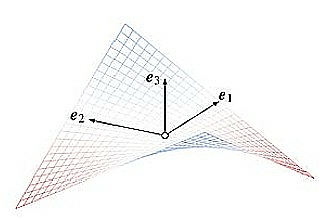MEMoRIAL-M2.8 | Analysis of curved photovoltaic panels with a novel shell theory and a global-local approach
Projektleiter:
Projektbearbeiter:
Haghi Choobar,
M.Sc. M.Sc. Moharam
Finanzierung:
Forschergruppen:


Background
The structure-mechanical analysis of such structures still poses major problems, since no adequatetheoryis available and classical continuum-mechanical models lead to immensely high computational complexity. In the context of industrial applications such an effort is not responsible, so the experimental analyses often have to be carried out.
Objective
The main goal of this project was developing a finite element based on a novel shell theory to analyse the sandwich structures with soft core layer (anti-sandwich structures). To achieve such an objective, a robust layer-wise theory for the structural analysis of doubly structures have been used.
Methods
To develop the element, the principal of virtual work was derived according to the layer-wise theory. Next, the shape of the element, the number of nodes, and the number of degrees of freedom have been determined. Afterwards, by choosing adequate shape functions, the source code of the element was written using the Abaqus subroutine user element. Then, the element has been integrated into finite element analyses using Abaqus. At the end, rectangular photovoltaic module were modelled using the new element for verification.
Results
This research deals with modelling the structural behaviour of anti-sandwich shells subjected to mechanical loads. The introduced element (Shell-Lwt) can analyse anti-sandwich structures as plates, single curved shells, and doubly curved shells.
Conclusions
The balance equations and constitutive model for a single layer by using the simple shell theory were obtained. Since mechanical and structural properties of the different layers of photovoltaic panels differ widely, classical approaches for composite structures fail to predict correct results. Therefore, expanding the equationsfor three layered structure was doneusing the layer-wise approach. The result was the formulation of the boundary value problem ofthe overall structure for the three layered composite structure. Since the solution of the formulated boundary value problem in closed form usually tightens a too narrow a frame for practical problems, a procedure for the numerical treatment by meansofthefinite element method was introduced. Therefore, a variational principal was exploited to gain a weak form of governing equations. This form was used to drive the discretized equation of motion. By using a classic finite element type and through the consideration ofartificial stiffening effects, the numerical formulation gained in efficiency and accuracy.
Orignality
The strategy developed here is particularly useful in the design and the development phase of anti-sandwich structures. With the numerical solution approach provided here, it is possible to predict the global structure behaviour as early as in the product development process, which can save high costs for experimental analyses.
Keywords
Curved photovoltaic panel, anti-sandwich structures, simple shell theory, layer-wise theory, finite-element analysis
The structure-mechanical analysis of such structures still poses major problems, since no adequatetheoryis available and classical continuum-mechanical models lead to immensely high computational complexity. In the context of industrial applications such an effort is not responsible, so the experimental analyses often have to be carried out.
Objective
The main goal of this project was developing a finite element based on a novel shell theory to analyse the sandwich structures with soft core layer (anti-sandwich structures). To achieve such an objective, a robust layer-wise theory for the structural analysis of doubly structures have been used.
Methods
To develop the element, the principal of virtual work was derived according to the layer-wise theory. Next, the shape of the element, the number of nodes, and the number of degrees of freedom have been determined. Afterwards, by choosing adequate shape functions, the source code of the element was written using the Abaqus subroutine user element. Then, the element has been integrated into finite element analyses using Abaqus. At the end, rectangular photovoltaic module were modelled using the new element for verification.
Results
This research deals with modelling the structural behaviour of anti-sandwich shells subjected to mechanical loads. The introduced element (Shell-Lwt) can analyse anti-sandwich structures as plates, single curved shells, and doubly curved shells.
Conclusions
The balance equations and constitutive model for a single layer by using the simple shell theory were obtained. Since mechanical and structural properties of the different layers of photovoltaic panels differ widely, classical approaches for composite structures fail to predict correct results. Therefore, expanding the equationsfor three layered structure was doneusing the layer-wise approach. The result was the formulation of the boundary value problem ofthe overall structure for the three layered composite structure. Since the solution of the formulated boundary value problem in closed form usually tightens a too narrow a frame for practical problems, a procedure for the numerical treatment by meansofthefinite element method was introduced. Therefore, a variational principal was exploited to gain a weak form of governing equations. This form was used to drive the discretized equation of motion. By using a classic finite element type and through the consideration ofartificial stiffening effects, the numerical formulation gained in efficiency and accuracy.
Orignality
The strategy developed here is particularly useful in the design and the development phase of anti-sandwich structures. With the numerical solution approach provided here, it is possible to predict the global structure behaviour as early as in the product development process, which can save high costs for experimental analyses.
Keywords
Curved photovoltaic panel, anti-sandwich structures, simple shell theory, layer-wise theory, finite-element analysis
Anmerkungen
Wiss. Co-Betreuende / Scientific Co-Supervisors: Prof. Dr.-Ing. Daniel Juhre (OVGU:FMB/IFME)
Publikationen
Die Daten werden geladen ...
Kontakt

Prof. Dr.-Ing. habil. Dr. h.c. Holm Altenbach
Otto-von-Guericke-Universität Magdeburg
Universitätsplatz 2
39106
Magdeburg
Tel.:+49 391 6758814
weitere Projekte
Die Daten werden geladen ...

